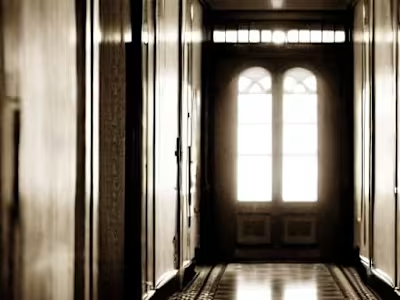Salem Witch Trials YouTube Script
Like this project
Posted Mar 26, 2024
Short script for a YouTube voiceover production discussing the horrors of the Salem Witch trials. Complete with edits and revisions.
Likes
0
Views
16
Title: The Deep Dark Secrets of the Salem Witch Trials
Introduction
Narrator (Voiceover): In mid-February 1692, a bitter cold front washed over the small oceanfront settlement of Salem, Massachusetts. Puritan settlers nestled under the warmth of their quilts and stoked their fires as the chilling percussion of winter winds bashed against their fragile wooden houses. Despite this grim weather, a lone man walked quickly down the winding streets of the village, gripping a large dark bag. Eventually arriving at a well-lit cabin, he could hear even from outside the wooden door the horrid screams of a girl, so loud and resounding that they cut through the sound of the wind as though she was possessed by a banshee.
The source of the screaming heard throughout the village that fateful day in 1692 was 9-year-old Betty Parris who, along with her 11-year-old cousin Abigail Williams, had been beset by terrible fits that seemed to only be getting worse as time went on. Fearing the worst, Betty’s father, Reverend Samuel Parris had called for the doctor, seeking any possible solution to his daughter’s worsening condition. Upon entering the small cabin, the doctor, who rushed to the house through terrible weather, was greeted with a terrifying sight. Both Betty and Abigail seemed to be screaming and acting in unholy and entirely unexplainable ways. Lacking any further explanation, the doctor delivered his official diagnosis to Reverend Parris: this was the result of supernatural interference.
Thus began the Salem Witch Trials, one of the strangest and darkest episodes in New England’s history. By its conclusion, the town would bear witness to 10 cases of affliction by witchcraft and 20 violent, harrowing deaths, each more gruesome and bizarre than the last. What led to this terrifying period in this quaint Puritan village, and just what or who was behind it all? Stick around to the end to find out for yourself as we discover the dark secrets of the Salem Witch Trials.
[Cut to: Intro]
The Accusations Begin
Narrator (Voiceover): After diagnosing young Betty with paranormal interference, the doctor confirmed that her cousin Abigail suffered from the same unexplainable affliction. Both girls had been experiencing these mysterious fits for almost a month, deeply troubling the community. Fortunately, by this point, the Reverend Parris had, through prayer and fasting, deduced that some form of bewitchment must be the cause of this interference. Given the girls’ prominent familial ties in the community, Parris figured they were prime targets for a black magic hex or spell. With hope dwindling, Reverend Parris turned to his slave, Tituba, who claimed to know of an “anti-magic” ritual.
On February 25, Tituba began the intensive ritual which involved creating a small cake from the afflicted’s urine mixed with rye before feeding the amalgamation to a dog. She claimed this would work as a counter-spell and harm the witch at the source of the magic simultaneously, which should cure the girls. At around the same time the ritual was conducted, two more village girls would fall ill with the same fits as Betty and Abigail. Reporting attacks from apparitions and ethereal beings, 12-year-old Ann Putnam Jr. and her friend would come forward stating that three women had appeared to them in visions during these attacks. Among the names given was none other than the ritual master herself: Tituba, who Parris began to suspect had deceived him with tales of the “anti-magic” ritual. Instead, she used the ritual to tighten her spell’s grip on the girls.
Citing the obvious connection between the “anti-magic” ritual Tituba had been performing and the attacks on Ann and her friend, warrants were issued on February 29 and also included Sarah Osborn and Sarah Good, who were all violently hauled off to await an uncertain trial that had a very different outcome than what anyone expected. The following day, March 1, the three women were chained and bound before being transferred to the village meeting house where they stood before two local magistrates. Despite an intense line of questioning, both Good and Osborn would reaffirm their innocence in front of their peers. The entire narrative would change, however, when Tituba was brought forward.
Under immense pressure, Tituba at first seemed to easily shrug off the accusations now laid before her. As time went on, though, cracks began to appear in her defense. She began to quote details she never should have been aware of, and occurrences she never witnessed. Before long, Tituba started to break down. With one final glance at both Good and Osborn, Tituba admitted what she had been holding back this entire time: she was part of a coven of witches, as were Good and Osborn. What’s more, she admitted there were several others, though she didn’t know exactly who, since they had been communicating strictly through the magic their victims imbued them with. Infuriated by these new revelations, the townsfolk seized all three women and dragged them back to prison, marking the commencement of the Salem witch hunt.
Hysteria Takes Hold
On March 3, an unsettling transformation occurred. As Betty, Abigail, and their friend appeared to suddenly recover from their afflictions, Ann Putnam Jr. began deteriorating at an increased rate. What’s more, she was now joined in her ailing life by her mother and the family servant. The three women would make several statements to the magistrates and Reverend Parris about a continuous onslaught of spectral attacks. They claimed the villagers behind these new attacks had revealed themselves inadvertently during a number of the encounters and provided a short list of two names including an elderly woman and Rebecca Nurse, both of whom were examined before being sent to jail under the testimony of the afflicted witnesses. Finally, as both women were incarcerated on March 24, the village breathed a collective sigh of relief. Little did they realize, the end was hardly near as the court continued to investigate even more people.
In early April, the once-improved Abigail Williams abruptly descended back into affliction. During her reemerging fits, the young girl would burst out in tears from pain caused by a specter she claimed resembled the wife of John Proctor, who himself had been an outspoken skeptic of the witch hunt since Rebecca Nurse’s initial arrest. John had been keenly watching his servant girl in the subsequent weeks, as she had come forward as a victim of Nurse’s hex during her examination in March.
John’s vigilant watch would have consequences for both he and the servant as, by the end of April, they had both been arrested on charges of witchcraft. Much to Proctor’s dismay, arrests of his wife, along with Giles Corey, Abigail Hobbs, and another woman also ensued throughout the month. As the suspected witches were torn from their families and held in secure locations, they were examined one by one by the magistrate assembly, turning up little evidence until one confession implicated this entirely new set of witches. Abigail Hobbs would join Titula in confessing to the nature of the witchcraft. She would say that, despite their best efforts to conceal the spellcraft they had been wielding, the witches had gotten sloppy and, in doing so, exposed themselves. She would go on to confirm that all of the accused up to this point were indeed members of this coven and that more still existed.
Horrors would continue to unfold following the death of one of the three original Salem witches, Sarah Osborn, on May 10 in a holding cell in the nearby city of Boston. Her body mysteriously disappeared from the prison that same night despite being watched by several well-armed guards. This unexplained event occurred shortly after Reverend George Burroughs passed through the region on his way to Salem, having been served an arrest warrant near the beginning of the month for his alleged contributions to the witchcraft. The reverend had previously served Salem Village for 30 years prior and had left abruptly one day, which never made sense to many of the locals. Almost immediately upon his arrival in Salem, many of the previously revived victims began to once again fall ill.
Now in the presence of Burrough’s aura, even Titula’s husband was compelled to testify against all of the accused. It seemed to the villagers that as the witches were collected and taken into custody, their power only grew, even in captivity or death. It seemed to the villagers that Osborn’s death was perhaps the harbinger of worse things to come.
The Executions
Narrator (Voiceover): Some relief came amidst the anxiety stirred by Burrough’s arrival when the Court of Oyer and Terminer was established on May 27. This court, created through a new charter, was tasked with officially trying cases of witchcraft. Up to this point, the examinations had been preliminary and as such, the villagers were forced to wait in fear until a new court could be appointed to try the accused officially. The following month on June 2, Bridget Bishop, a newly branded witch was brought before the magistrates. Standing trial amidst a maelstrom of fear, she was ultimately convicted on multiple counts of witchcraft. On the gloomy morning of June 10, she was beaten, chained, and hanged at Gallow’s Hill, much to the relief of the beleaguered villagers who felt a weight lift off their small community. Things, it seemed, were finally beginning to turn around in the small cursed village.
Yet still, following the first execution, frightened young girls continued to speak of violent spectral attacks in the dead of night. With urgency, the newly formed court hastened their crusade, determined to purge the village of the remaining witches before the cursed magic condemned them all to a terrible fate. On July 19, several more witches were tried and paraded to Gallow’s Hill to be hanged including 3 newly arrested women, the elderly Rebecca Nurse, and Sarah Good, the final remnant of the originally incarcerated witches. As Good ascended the gallows, her eyes were turned pitch black and, as the townfolk looked on, she recited to them a simple, yet lingering curse, “If you take my life, God will give you blood to drink!” As the ropes tightened around the necks of the condemned, it is said that a cool breeze settled upon the hill and the smell of rot which seemed to emanate from the village for the past months suddenly vanished. But the job was not over yet. With otherworldly attacks continuing to persist, this meant that more witches remained, and with the new tribunal in place, there were even more disturbing methods devised to eliminate anyone who was suspected of being a witch…
August 19 would see the hanging of Reverend George Burroughs, John Proctor, and 2 other men take place. Proctor, despite his efforts to prove the tribunal wrong, would ultimately end up only incriminating himself, as suspicions lingered around his involvement with his servant, who, alongside his wife Elizabeth, had once again fallen ill. Reverend Burroughs was cited by a Boston minister as having perfectly recited the Lord’s Prayer just before his execution. Despite the claim that witches were unable to recite any holy verse, the minister simply stated, “The Devil has often been transformed into an Angel of Light,” before carrying out the sentence.
A month later on August 19, the 71-year-old Giles Corey, who, like John Proctor had argued against the authority of the court, was beaten and dragged to a field near the village jail. Here he was tied and staked to the ground before being asked a series of questions regarding his and his wife’s involvement in the bewitching of the village. Every time he was asked, Corey refused to answer, and each time he refused, a large, flat rock was stacked on his chest. After some time, Corey began to turn blue as he slowly suffocated under the pressure of the stones. Still, the posse continued to ask questions and still he refused to answer. Eventually, enough weight was added that his ribs cracked and broke with an audible crunch. After several hours of this torture, Corey died from suffocation and internal hemorrhaging.
On August 22, the final procession of darkness unfolded when the last of the witches were hanged and their bodies burned when Giles’ wife, and 7 others, were executed on September 22. With their deaths, the town finally returned to some semblance of normality. The visions and attacks seemed to cease entirely, and peace once again settled upon the little Puritan village by the sea. Or did it?
Conclusion
Narrator (Voiceover): In January of the next year, 1693, the Superior Court had signed the death warrant for 8 more convicted witches from the prior year. In total, 56 of the accused remained incarcerated on charges of witchcraft. With further executions slated for February, a strange turn of events began to unfold. Governor Phips, the highest authority in the region, stepped in and overturned the executions. Following this, he released all of the accused provided they paid their jail fees. By the end of 1693, nearly every accused witch would be free and active within the community again. And yet, the spectral attacks never restarted. In fact, by the end of the decade, official apologies had been issued by the courts, and by the local government. Reverend Parris resigned, and one of the magistrates who oversaw the trials even issued a formal apology. There was perhaps an even more shocking revelation yet to come, though.
The apologies and confessions from local individuals and organizations alike all began to weigh heavy on the hearts of those involved. Some questioned their involvement in the trials, and others continued to insist that they were never involved from the start. Others still whispered words of dissent and still claimed that the hunt and trials had been necessary to destroy the evil that plagued the land. Finally, in 1706, 14 years after the initial trials, Ann Putnam Jr. officially apologized for her role in the Salem Witch Trials. Most shockingly, her confession admitted, in front of the entire Salem congregation, that it was she who had been under the delusion of the devil, and not the accused.
Now over 3 centuries later, the evil reality behind the Salem Witch Trials still lingers with us. The early Puritan New England region was a place of vast unknowns, bordered by impenetrable wilderness, terrifying disease, and unfathomably difficult winters. Salem itself was a small town that had been plagued by religious isolationism for decades leading up to the trials. Though the early New England Puritans were steadfast in their faith, their dedication also made them susceptible to intense paranoia. With a deeper understanding of this, it comes as no surprise that rumors of witchcraft and fast accusations appeared following that fateful February day. A combination of pure hysteria and confusion of the highest degree ultimately led to the gruesome deaths of 20 undeserving people.
Even today the truth remains: the Salem Witch Trials were never about witches, spells, or mysterious illnesses that seemed never to subside. Instead, they delved into a darker, more sinister, and damaging theme that resonates today just as it did more than 3 centuries ago: the power of a rumor. It was the whisper of witchcraft, born from the otherwise ordinary fits of a pre-teen girl, and her friends, that plunged the community into chaos. This serves as a stark reminder of how easily fear and suspicion can spiral out of control, resulting in grave injustices and irrevocable consequences. The true horror of the Salem Witch Trials lies in mankind's susceptibility to condemn neighbors and loved ones based on the flimsiest of rumors. And as shadows of suspicion continue to grow in our communities even today, one can only wonder: when will the next whisper of fear grow into a cry in the night?
[Cut to: Outro]
Narrator (Voiceover): Do you think the Witch Trials could have been avoided, or were they inevitable? Let us know in the comments below.
If you enjoy learning about creepy places like Salem, be sure to check out our previous video on the Stanley Hotel. Click the link to go straight there.
[Cut to: End titles]





